President's Message
2017 has been particularly eventful. In commemoration of the 100th anniversary of WWI an event was held at the Carillon Towers at Byrd Park. Throughout the year, events were held to commemorate the 75th anniversary of the US entry into WWII. On July 4th at Meadow Farm a special tribute to WWII was held and the Society featured the USS Henrico, which was named for Henrico County in the 1940's. A special exhibit is on display at the Western Government Center Administration Building on Parham Road of the USS Henrico collection on loan from HCHS. HCHS sponsored a Homefront Tribute at Sandston Memorial Recreation Center (formerly a USO Center in the 1940's) to honor WWII Veterans and those who supported the war effort back home. The Society visited the Richmond Railroad Museum, which houses a treasure trove of history relating to the surrounding area of which Henrico County was very much a part. HCHS was represented in the parade and had an exhibit at Glen Allen Day. We also had an exhibit at the Virginia State Fair. We participated in a workshop on ways to promote Henrico County tourism. (History was at the top of the list.) In October we took a field trip to tour historic Mount Airy, ancestral home of the Tayloe family and Menokin, the home of Francis Lightfoot Lee, a signer of the Declaration of Independence, and his wife, Rebecca Tayloe Lee. (If you missed this trip, both of these historic homes along with Sabine Hall will be featured in Garden Week 2018) A historic roadside marker dedication was held honoring the Ferguson family of Malvern Hill on historic Rt. 5 along the Virginia Capital Trail. The Ferguson family has been instrumental in the historic land conservation efforts of Malvern Hill Farm which has been the site of conflicts of the American Revolution, the War of 1812, and the American Civil War.
The one connecting thread of most of the year's events involved a recollection of history. We have actively collected the most amazing stores, many of which would not have been known otherwise because they are personal experiences. I might add, the year is not over yet.
The StoryCorps project at the American Folklife Center at the Library of Congress is promoting for the third year its "Great Thanksgiving Listen," which encourages high school students to record a conversation with an elder over the holidays. An app has been made available so that photos and videos can be added to their stories and upload them to an online archive. The Henrico County Historical Society is about to launch its own oral history project at a location near you. Stay tuned for future annoucements.
As we gather around our holiday tables, may we give thanks for all our blessings.
Best wishes,
Sarah Pace
President
>Back to Top<
December Quarterly Meeting
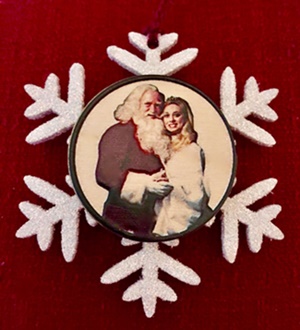
Our December Quarterly Meeting is Sunday, December 3rd starting at 2:30PM. It will be at the Meadow Farm Museum Visitors Center, located at 3400 Mountain Road in Glen Allen, VA 23060.
Meet Donna Deekens, the Miller & Rhoads Snow Queen.
The nominee for the Director of the Varina District is Dana Hanson. This will be approved at the December meeting.
See you there!
>Back to Top<
All Aboard!
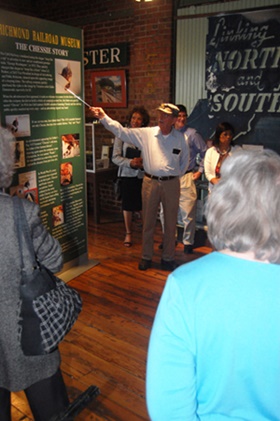
Calvin Boles, curator of the Richmond Railroad Museum, guides the members of the Henrico County Historical Society on a tour during the society's September meeting.
>Back to Top<
Tribute Marks 75th Anniversary
On September 2, 2017, the Henrico County Historical Society held a Homefront Tribute at the Sandston Memorial Recreation Center, originally a USO Center, to commemorate the 75th anniversary of the United States' entry into World War II.
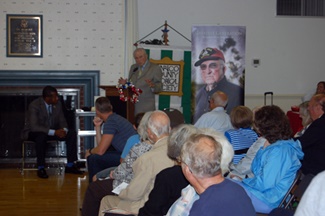
Marine veteran, University of Richmond Chancellor and representative of the Greatest Generation Foundation and Spirit of '45, Dr. Bruce Heilman was the keynote speaker.
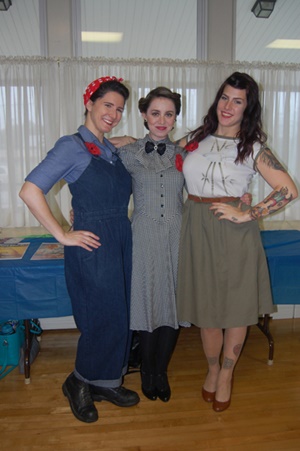
Valentine Wendell, Violet Devereaux and Stephanie Boehless and other members of the River City Bombshells came clad in their trademark 40s attire.
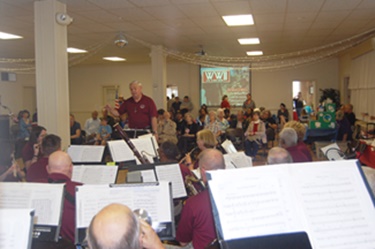
Randy Abernathy and the Henrico Concert Band performed patriotic music.
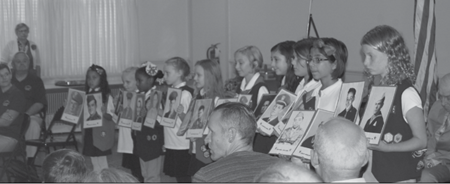
American Heritage Girls honored individual solders from the war.
>Back to Top<
Henrico History Connects to Orange County Through a Wine and a Woman
You never know where history will take you. It recently took our family a short way west to Orange County, where we met kindred spirits - Bethany Sullivan, and Dennis and Sharon Horton. And we got to meet them in a wonderful institution and a gorgeous locale where evidence of their vision was on display - a vision that has resulted in the serendipitous preservation of Henrico's cultural, artistic, gustatory and agricultural history.
The last issue of this newsletter had dealt with the Payne Limner, the itinerant eighteenth-century artist who worked in Henrico and other counties and is known by that name because of the ten portraits he produced of the Payne family in Goochland. His Alexander Spotswood Payne and His Brother, John Robert Danbridge Payne, with Their Nurse has been a personal favorite of ours at the Virginia Museum of Fine Art, and we had also traveled to the DeWitt Wallace Museum of Decorative Arts in Williamsburg to see his portrait of Martha Dandridge Payne. So when a recent online posting indicated that a Payne Limner painting had gone on display at the James Madison Museum of Orange County Heritage, we had to see it. And since the newsletter had also contained an earlier article on Daniel Norbone Norton, the Henrico doctor who developed the Norton grape in the early 1820s, it made perfect sense to include a stop at the Horton Winery and its vineyards in Orange, where the grape had been reintroduced to its home state after a long absence.
Our first stop was at 129 Caroline Street in Orange, Virginia, where Bethany Sullivan serves as administrator for the James Madison Museum of Orange County History. This hidden gem of a museum houses possessions of Presidents James Madison and Orange-born Zachary Taylor, agricultural implements, an early eighteenth-century cube house, a Black History Room and more. We loved it all, but we were there for the painting, the Payne Limner's portrait of Ann Spotswood Payne. The painting and the story of its restoration did not disappoint.
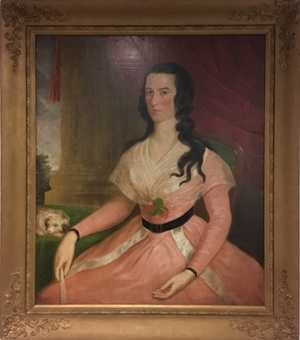
Ann Spotswood Payne. ca. 1790-91. 39 1/4" x 32 1/2". Courtesy of the James Madison Museum of Orange County History.
Donated to the museum by the estate of Katherine "Kitty" Shiflett of Orange in 1999, the painting was in serious need of restoration, and Bethany Sullivan was determined to see it done. She contacted several large Virginia museums who declined to undertake the conservation project, and estimated restoration costs ran as high as $13,000, far beyond the limited budget of the James Madison Museum. But an application for a grant from the "Save Our Virginia Artifacts" led to an appointment with the DeWitt Wallace Museum, where the staff agreed to look at the painting. Bethany said she wrapped the painting up and drove to Williamsburg, where the surprised staff opened the wrapping and exclaimed, "It's the lost sister!"
It was the second portrait of Ann Payne, the first of which is in the Winterthur in Delaware. With the painting's authenticity and significance established, the University of Delaware's conservation program at Winterthur undertook the project in 2015. Two years and $100 later (the University of Delaware's Art Conservation Program at Winterthur charges only that nomimal fee to cover materials for the paintings that it accepts) Ann Spotwood Payne's portrait returned to hang in the James Madison Museum of Orange County Heritage.
The restoration involved cleaning, relining, restretching, inpainting losses and abrasions and varnishing; and the project revealed a few items of interest. The painting was on its original stretcher, evidence by the finding of the original tacking pattern, and those original tacks were sent back to the James Madison Museum, where they are kept in a small bag. Its ornate frame, quite different from those frames on other Payne Limner works, was not thought to be original; but tests indicated that its age was consistent with the 1791 time of the painting. Anne wa married to Thomas Mann Fleming on April 1, 1791, and this painting came down through the Fleming family; so the date and fancy frame seem to indicate that this portrait may have been a wedding present. And that possible wedding present had suffered some abuse because the cleaning process indicated that the painting had been subjected at some point to numerous applications of Windex, not an ideal treatment. And perhaps most intriguing of all was the undecipherable inscription found in a scan of the portrait, an inscription that could reveal the name of the otherwise anonymous Payne Limner.
Museum administrator Bethany Sullivan's efforts returned a work by an artist asscoated with Henrico County to the condition it deserves, and the work of Dennis and Sharon Horton has returned a grape important to the American wine industry and developed in Henrico County to the state where it was "born." Its place of rebirth is just down the road from the James Madison Museum on the northeast side of a long, broad hill on Berry Hill Lane. We drove up the lane to a small, green building from which the Horton's, along with their dog Syrah (named after the grape), oversee the workings of the 53-acre vineyard. They directed us to follow the lane around to the edge of the sun-drenched vineyard with its rows bearing wood signs indicating the particular variaty grown and down to the bottom of the hill where their ten and half acres of Norton grapes grow.
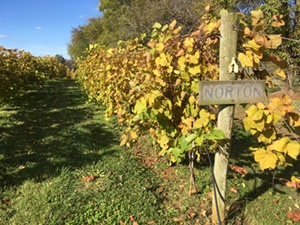
Norton grapes. Ten and a half acres of the Henrico-developed grape, re-introduced to Virginia by Dennis and Sharon Horton, grow at the foot of the Horton Vineyard in Orange, Virginia.
Those grapes grow from stock acquired from Stone Hill Winery in Hermann, Missouri, Dennis Horton's hometown. Sharon Horton told us they planted the Norton in 1990, producing their first Norton wine four years later. The Norton had been important in Virginia winemaking, with wine from it bottled by the Monitcello Wine Company receiving an international award in Vienna World's Fair in 1873. But the grape pretty much disappeared from the state after Prohibition - that is until Dennis Horton brought it back. When asked by Amy C. Evants in a 2008 interview for Southern Foodways Alliance why he had decided to plant the Norton, he said: "That was basically a no-brainer. I mean there's not many states that have a native grape, okay, or a winemaking grape that orginated in the states. And I thought it would behoove the marketing end of the stick to be able to deal with a grape that came from Virginia, made in Virginia, and produces a nice bottle of red wine. And it proved to be successful" (www.foodwaysalliance.org).
So the Henrico-born grape is once again producing wine in Virginia, and the Horton's are responsibe for its renaissance. They are also in part responsible for providing a fitting tribute to the developer of that grape, Dr. Daniel Norbone Norton, whose gravestone in Shockoe Hill cemetery was worn to the point of illegibility. Dennis and Sharon Horton joined the Friends of Shockoe Hill Cemetery and other contributors to place a new monument at the gravesite, which was dedicated on September 10, 2017.
Like Bethany Sullivan's efforts have restored a bit of history with connections to Henrico County, so too has the work of the Hortons reclaimed a bit of our county's past. They should be commended. Not only do they remind us of the reach of our history, but they also illustrate that the preservation of history requires many hands and forms bonds among them. Although he was explainining the inter-connectedness of all elements of nature, Ralph Waldo Emerson might well have been describing the preservation of history when he wrote, "All are needed by each one."
Joey Boehling
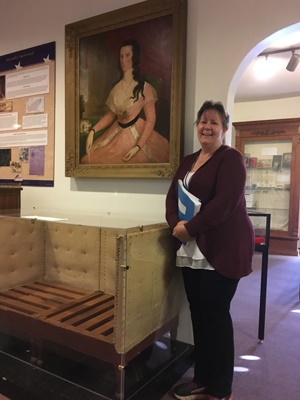
Two memorable women. Assistant Administrator of the James Madison Museum of Orange County Heritage Bethany Sullivan stands beside the newly Payne Limner painting of Ann Spotswood Payne.
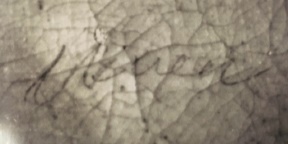
Undecipherable. The faint inscription found in a scan of the painting might provide insight into the Payne Limner's identity.
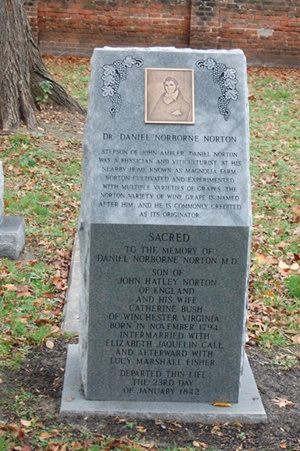
Norton remembered. A newly placed monument featuring a brass portrait and grape clusters now graces the Shockoe Hill Cemetery gravesite of Dr. Daniel Norbone Norton.
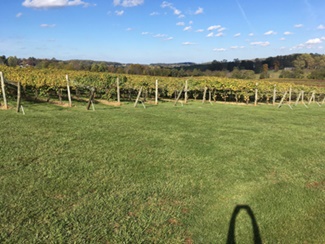
Wine on the Vine. The 58-acre Horton vineyard as viewed from the south side.
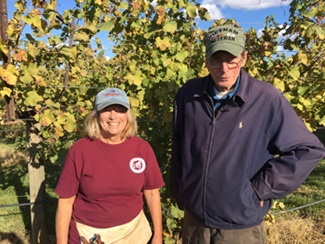
Viticultrists. Sharon and Dennis Horton pose with their vineyard serving as a backdrop.
>Back to Top<
Now You Know: Patriotism and Fashion Join Hands to Make Warsages
Congratulations go to Mary Jo and Haywood Wigglesworth for identifying the war savings stamps contained in the last issue's mystery object. Those stamps were part of a program that began as part of the effort to raise funds for our participation in World War II and continued a program that had begun in order to raise funds for World War I. Mary Jo wrote that Haywood recalled them being sold in schools even in the 1950s.
The war savings stamps introduced during World War II were released in five different denominations - 10 cents, 25 cents, 50 cents, one dollar, and five dollars. Each one featured the same image of a Minuteman statue, and each denomination was a different color: rose red for ten cents, green for twenvty-give cents, ultramarine for fifty cents, gray for a dollar, and brown for five dollars. While they earned no interest, individuals could accumulate them in collection booklets. Filled booklets could later be used to purchase Series E war bonds, which did earn interest.
But there is more to our mystery object than just the stamps. They were one part, and of course the central part, of the "Warsage," a corsage meant to prompt the sale of the war savings stamps. This promotional campaign was undertaken largely by women's groups around the country with national publicity helping to make them patriotic fashion statements.
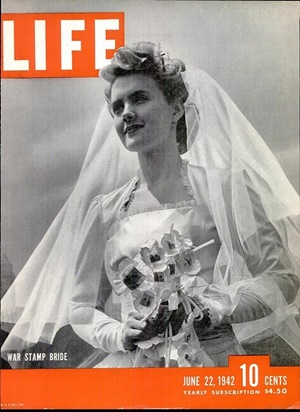
One example of that publicity is the Life magazine cover from June 22, 1942, seen at the left. Text inside the magazine explained the image. It read: "Allen Allardice is only 19 but she has already been a bride three times - on a cover...The bridal bouquet she carries is made of 10-to-50 cent war stamps wrapped in cellophane, enough to buy a $25 bond. Bouquets and boutonnieres are made to be worn until the cellophane cracks, [the stamps] should then be pasted in [a] book or exchanged for bonds and a new boutonniere purchased. Furlough brides were among the first to adopt the war-stamp bouquet."
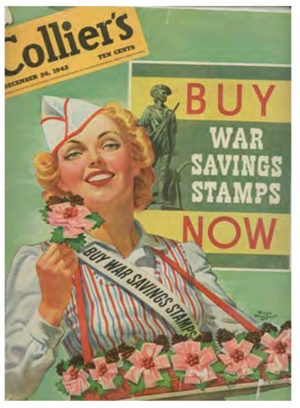
Corsages for the war effort.Two magazine covers promoting the war stamp corsage campaign - Collier's magazine of December 26, 1942, seen left, and Life magazine of June 22, 1942, seen above.
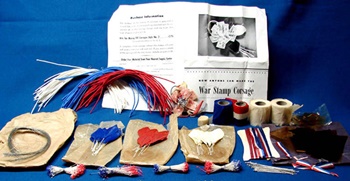
Contents of a War Stamp Corsage kit.
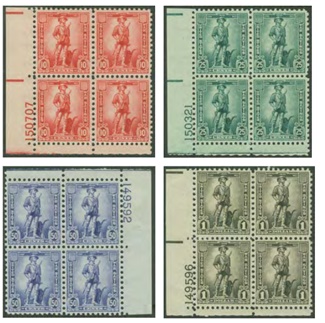
Different Minute Man stamps.
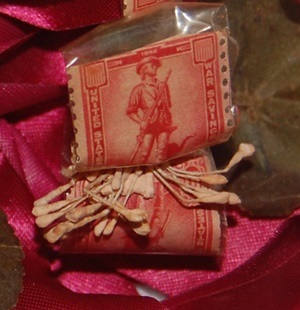
The block of stamps above are like those enclosed in cellophane in the corsage was our last mystery object.
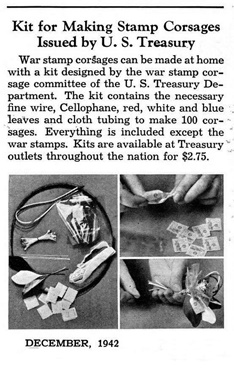
An advertisement from the December 1942 Popular Mechanics magazine telling how to order the kit.
>Back to Top<
What Do You Know?
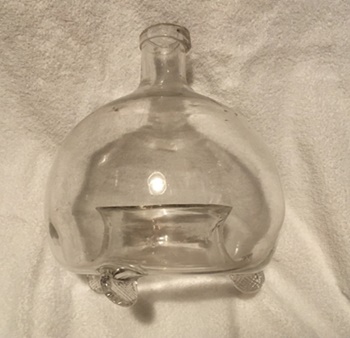
The item below is hand-blown glass, 8" tall and 6" wide. The opening at the top is meant to accommodate a cork or stopper. The curved in opening at the bottom is 2 1/2" wide.
Do you know what it is?
Email your answers to:
jboehling@verizon.net
>Back to Top<
News 2017: Fourth Quarter
First Quarter | Second Quarter | Third Quarter
Home | Henrico | Maps | Genealogy | Preservation | Membership | Shopping | HCHS
|











